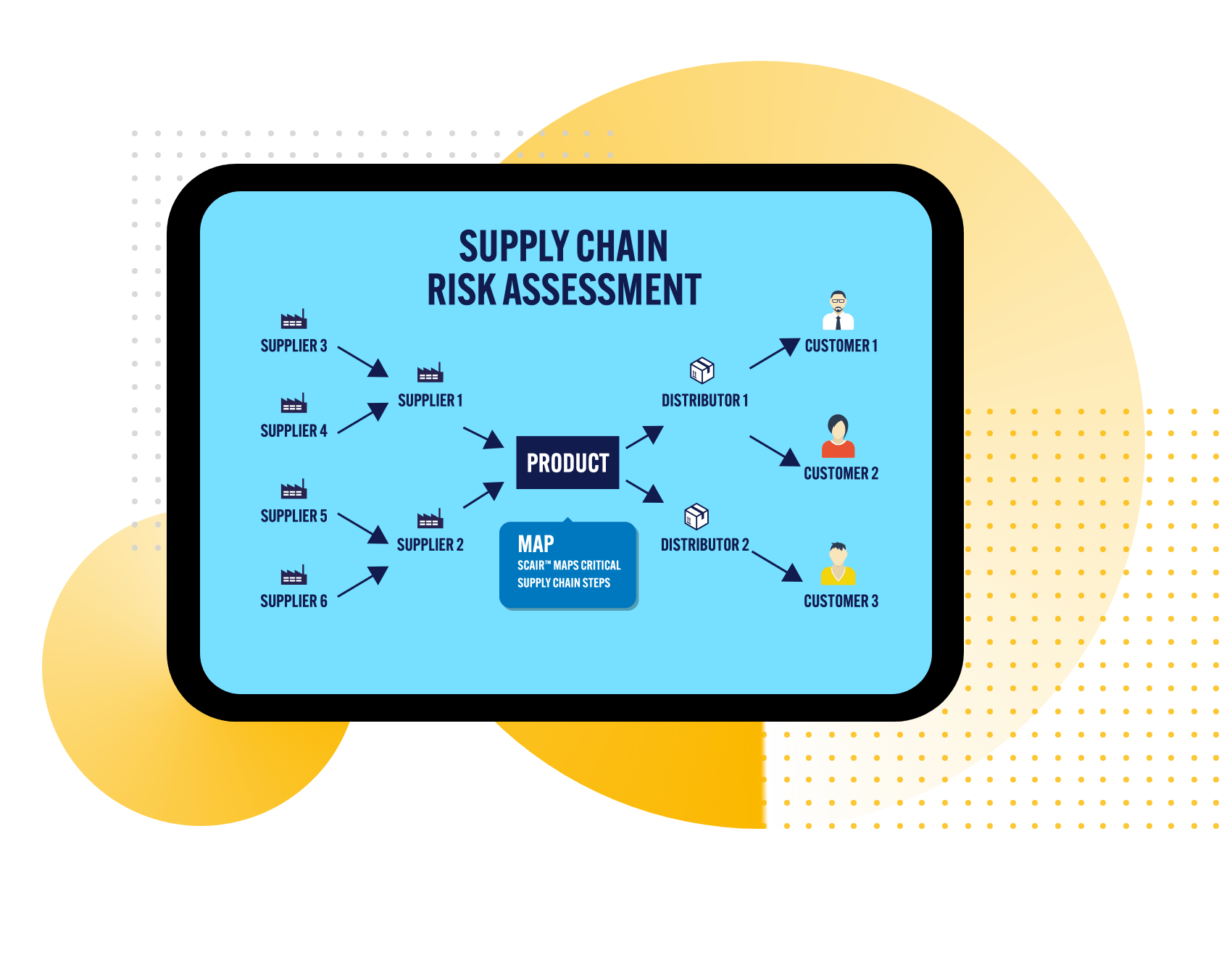Who uses SCAIR®?
From supply chain managers to insurers, find out why SCAIR® is a business critical tool


Supply Chain Risk Managers
- Justify mitigation spend (cost-benefit analysis) and resist the push to reduce safety stock by putting a value on supply chain exposure.
- Make better decisions by converting flat Excel files into dynamic, user-friendly maps that reveal supply chain vulnerabilities.
- Get an accurate picture of exposures in single locations by viewing total exposure by site rather than material.
- Improve supplier vulnerability analysis by taking outputs from the materials management system and consolidating them by supplier location.
- Present a true picture of single supplier dependency and vulnerability by targeting the manufacturing location (rather than a distributor or agent).
- Stay ahead of the competition with alerts on issues that impact your critical suppliers, for instance, non-compliance and natural hazards.
- Get customised, targeted reports using PowerBI.
Insurance Managers
- Generate accurate, realistic business interruption values to enable more efficient insurance buying.
- Optimise insurance procurement by getting the right suppliers on cover with the right limit – and only buy cover where you need it.
- Reduce costs and reliance on specialist insurance/supply chain risk consultants.
- Estimate the true magnitude of exposure across a range of risk scenarios: fire, flood, earthquake, regulatory closure and insolvency to accurately estimate accumulations for different types of risk*.
- Generate exposure-by-location data and use it with Monte Carlo analysis to understand the financial impact of risk and uncertainty at single sites.
- Determine the value of investment in mitigations by comparing pure and mitigated risk.
- Compile accurate exposure profiles without insurance-specific data – existing business information can be used with SCAIR to deliver accurate results.
*For example, an earthquake would accumulate exposures for different locations that share the same fault line; an insolvency scenario would explore the total company-wide exposure across different locations owned by the same organisation.


Management Consultants
- Accurately analyse your life sciences client supply chain risk with a tool specifically designed for their industry.
- Assess your client’s financial, physical and regulatory exposure profile in the wake of a prospective takeover.
- Undertake due diligence by generating a complete report on the risk quality of your client’s supply base, using regulatory non-compliance history.
Business Continuity Managers
- Make better, more informed decisions by converting flat Excel files into dynamic, user-friendly maps that visualise supply chain vulnerabilities.
- Create customised reports with exactly the right level of detail using PowerBI.
- Enhance visibility of exposures to single locations by getting a picture of the total exposure by site rather than material.
- Get an accurate estimate of value at risk. No need to rely only on straight revenue dependency by material – consider supply chain mitigations (alternative sources and stock) to get a more targeted gross profit exposure.
- Develop an accurate picture of downstream stock protection. Link suppliers to production sites and get SCAIR to calculate the total downstream stock that mitigates the exposure.


Insurers
- Help clients optimise the value of insurance cover by generating accurate, realistic business interruption values.
- Track BI location accumulation across the book to avoid any unpleasant surprises in the event of a loss.
- Assess a prospect’s financial, physical and regulatory risk profile to ensure they are high quality in terms of risk, or priced accordingly for less desirable risks.
- Save time generating loss exposures by taking data from a standard PDBI application form and generating exposures by site.
- Adjust clients’ premiums as appropriate – visualising year-on-year changes provides an understanding of variation in annual renewal data.
Procurement Managers
- Develop a true picture of revenue dependency by focusing on value/revenue at risk (by product/brand) rather than spend per supplier.
- Improve supply chain visibility and risk decisions by relating materials to the brands they serve.
- Understand total exposure to a legal entity by tracking risk accumulations by supplier location and then rolling them up by supplier entity.
- View material risk accumulations by category / sub category – this aligns with the typical procurement organisational structure and feeds into existing business reporting units.
- Get an accurate picture of downstream stock protection by linking suppliers to production sites.
- Keep a watching brief on non-compliance incidents in the supply chain and natural hazard alerts.


Corporate Reporting
- Ensure full disclosure by keeping a watching brief on non-compliance incidents in the supply chain.
- Adhere to mandatory Climate Change Financial Disclosure requirements by using exposure data to quantify risks associated with climate change.

Strengthen Your Supply Chains with SCAIR®
Talk to a supply chain risk expert now